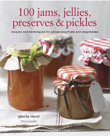IT’S SHOW TIME
Sunday August 16th 2009, 4:00 pm

The village fruit and veg show is only 2 weeks away, so I need to get my skates on. Last year I managed a 3rd prize for my crab apple jelly and a second prize for my damson chutney and I would love to do better this time round. As my book came out earlier this year, I now feel I have my reputation as well as fruit to preserve.
The blackberries round here are particularly plump and abundant this year. Last year I did manage to gather some but each berry was small with not a lot of juice. This year it is a very different matter. Yesterday evening I went out to pick some, along with my cat Beau. He wasn’t any help but did bring a certain cute factor to the proceedings. I managed to harvest a large plastic box full in a very short time and as it is still early in the season, I know there will be lots more fruit to come over the next few weeks.
The plan, to make blackberry and nectarine jam, as I picked up some nectarines in the supermarket this week, reduced with yellow labels! (I have become the yellow label queen). I made this preserve for the book and it was a great success. In the recipe it does have added spices in the form of star anise, cloves and cinnamon, but I’m going to forgo the spiced approach and hope the fruit flavours are tasty enough to stand alone. I do love using nectarines in jams as they have a lovely acidic flavour.
There are elderberries almost ready to pick here, so blackberry and elderberry jam is the next jam I’m planning. I love the idea of using two foraged-for-free fruits together.
Plum and elderberry, again there are lots of plums up for grabs on the trees a mere hop skip and a jump from my front door so it seems a shame not to use them up pronto.
Rhubarb and apricot jam, another real star from the book and fast becoming my signature jam, if you can have such a thing. My neighbours rhubarb keeps on coming and I’ve bought some French apricots, as I don’t grow them myself or know anyone with some to spare. So that’s it for starters. Next week is going to be a busy week.
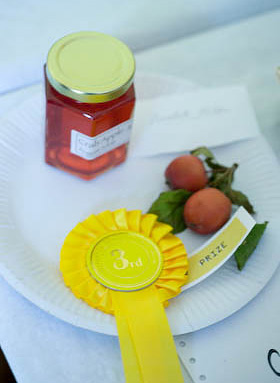
CRAB APPLE JELLY AT LAST YEARS VILLAGE SHOW
ELDERFLOWER CORDIAL
Friday June 12th 2009, 12:50 pm
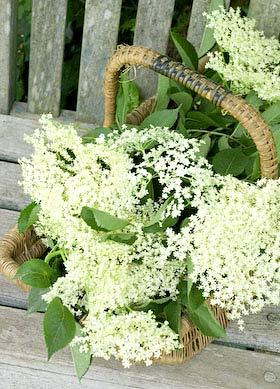
I grew up in a town and cordial was something you bought from a shop. When elderflower cordial became available in foodie shops and subsequently became very fashionable, to me it was as if it had only just been invented. It is of course a traditional drink that country folk have been making for centuries but that had never, to my knowledge, made it as far as the industrial north of England, not into our house at any rate. It is as easy as anything to make and round here, right now, the trees are heaving with these fluffy cream fragrant blossoms. Now is the best time to go out foraging to pick elderflowers and stock up with cordial.
The flowers are best picked on a sunny morning, when the warmth of the sun encourages the release of their exquisite floral scent. Choose fresh clean flower heads that are just off white to pale cream and discard any that are starting to yellow, then shake the flowers, face down, so any creepy crawlies fall out. Sniff the blossoms, ditching any with an unpleasant cat-pee vibe and go only for the sweetest floral scented ones. Go to work making your cordial as soon after gathering the flowers as you can. As mentioned in my last piece, citric acid can usually be bought from your chemist and apart from that ingredient, everything else is straightforward, just water, sugar, lemons and oranges.
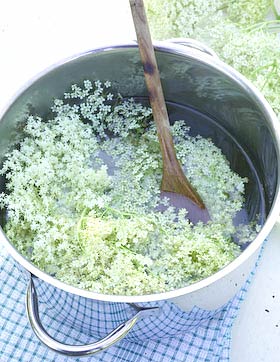
HOW TO MAKE ELDERFLOWER CORDIAL
Makes about 1.5 litres (2 1/2 pints)
20 fresh elderflower heads
1.5kg (3lb 5oz) sugar
40g (1 1/2oz) citric acid
2 unwaxed lemons, thinly sliced
2 oranges, thinly sliced
Place the sugar and 1.2 litres (2 1/4 pints) water in a large pan and warm slowly, stirring to dissolve the sugar, then bring to the boil. Add the flowers, bring again to the boil then remove immediately from the heat. Add the citrus fruits and citric acid, stir together, then leave covered in a cool place for 24 hours to steep.
Strain the cordial into clean dry sterilised bottles with clip tops or corks and label with the date. The cordial will last for a month or 2 unopened in the fridge. Once opened keep refrigerated and use it within a few weeks. You can freeze it in plastic containers, in which case it will keep for 6 months or more in the freezer.
Serve diluted with still or fizzy water to taste or use this syrup to flavour jams, desserts and icings.

‘Woman Beaten up over Asparagus Prices’
Tuesday May 19th 2009, 7:41 pm
…..not my words, but those of Reuters. Asparagus is obviously a vegetable that generates strong feelings.
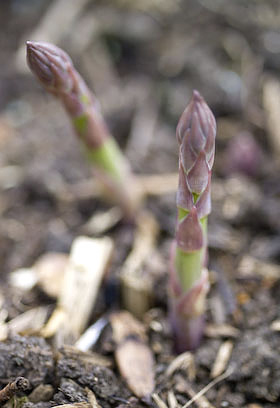
I never buy imported asparagus. For me the whole point is to savour the all too short British season; the 8 weeks that runs from the beginning of May to the end of June, and then it is over for another year. I only really took a shine to this vegetable a couple of years ago. Before that I couldn’t understand what all the fuss was about. I simply hadn’t cooked asparagus in a way that suited me so concluded it wasn’t for me. Now I absolutely adore the stuff and intend to make the most of it.
The key for me is to chargrill it and here’s how to do it. Wash the spears and break off the thick woody bit of stalk at the bottom if there is any (the stalk naturally snaps at this point). Blanch them in boiling water for just 60 seconds then remove to a piece of kitchen paper to dry them. Put a griddle pan to heat up, there is no need to oil the pan. Place the spears on a flat dish, season with sea salt and freshly ground pepper then drizzle with virgin olive oil. Turn the spears over with your hands to coat them, then lay them on the hot griddle, hot enough so you hear them sizzle the moment they touch the ridges.
Griddle them for a few minutes (depending on the thickness of the spears) before turning them over and griddling the other sides. You are aiming for some black charred marks where they touch the pan. You can eat them just as they are or pile on top of pasta with pesto and finish off with grated parmesan. I can eat them like this every day (for 8 weeks!). I used to chargrill the spears without blanching them first but now prefer them done this way. It cuts down the grilling time and keeps them plump and succulent.
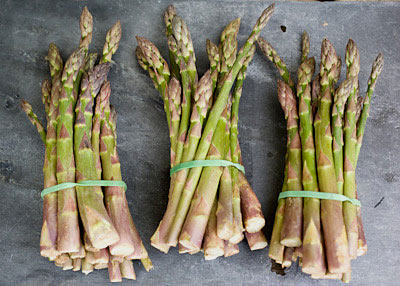
BAKE EARLY FOR CHRISTMAS
Tuesday November 11th 2008, 3:56 pm
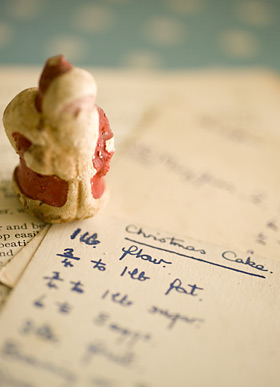
It is time to think about baking the Christmas cake. I’d like to say that I have an old family recipe passed down through the generations, but I haven’t and as I don’t bake a cake every year either, I have generally forgotten which recipe I followed the previous time. Delia is always reliable, I’m sure I’ve made hers on several occasions.
Last year my neighbour, John, decided he’d make a cake for each of his two daughters and was given several recipes by various people. He ended up making three cakes following three different recipes, not knowing which recipe would be the best. We discovered that if you bake your cake in a square or rectangular tin, as opposed to a round tin, you can then sample the cakes by slicing off one of the sides, which would eventually be covered in almond paste and icing anyway. For several weeks we had cake tastings in the afternoon, comparing the different cakes, deciding whether we preferred a recipe which had treacle in it or another one that included cocoa. Of course the more tastings we had, the smaller the cakes became. ‘Shall I just cut another slice off the other side?’, he’d say, ‘ yes why not’, I’d reply.
What was so great about these cake tastings was that it became much easier to recognise what an ideal Christmas cake should contain when there were others to compare against. This isn’t something we often get the opportunity to do, unless we work in the Good Housekeeping Institute. I realised that I’m not so keen on treacle in the mix as I think it gives a bitter taste.
Now the time has come round again to think about baking this traditional cake, I’m faced with the usual question of what recipe to follow. Every week at least one new cookery book enters this house and I love it when a vintage find has handwritten recipes sandwiched between the pages. I’ve found a recipe for Christmas cake in one of my old books, handwritten in fountain pen on an old postcard along with a second card explaining how to make marzipan and royal icing, so I shall take pot luck and make that one. Perhaps it will be someone else’s special hand-me-down family recipe. I forgot to mention the downside of cake sampling, which is that by the time Christmas comes you’ve had quite enough cake to last you for at least another eleven months.
BLACK IS THE NEW BLACK
Sunday August 03rd 2008, 8:11 am
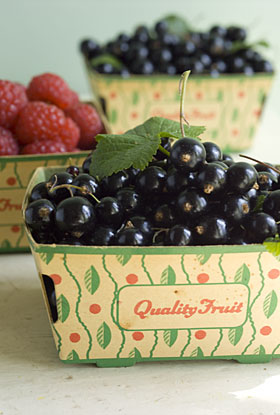
Everyone has food stuffs or flavours that they aren’t particularly fond of. Sometimes we decide early on that we don’t like something when in actual fact we just haven’t eaten it prepared in the right way. That’s what I’m like with blackcurrants. I think my mind was made up after drinking Ribena in my youth and without ever having tasted them freshly picked. My neighbours blackcurrant bushes are heaving with fruit right now and noone seems interested in using it up, so not keen to see a crop go to waste I have decided to harvest the berries (I do have permission!) and find ways of using them that might change my mind.
As I am in jam-making mode I thought I’d start with a preserve and am really thrilled with the result. Blackcurrants are a great fruit to work with as they have a distinctive flavour with a tart kick, quite similar to damsons, which I really love. The recipe that follows is somewhere between a jelly and a jam; it is without the bits, as the skins and seeds are pureed out, but doesn’t need straining through a muslin bag as required to make clear jelly. The resulting jam has more body and texture than a jelly. Rather than the fruit being boiled to smitherines, the cooking time is minimal and so ends up absolutely bursting with flavour. This jam has a lower sugar content than usual which gives a lovely softish set and as the skin of the currants are removed there is no need to cook them first by boiling the fruit in water. It has just the right sharpness to make it ideal as the filling for a chocolate cake and is fab slathered on sourdough toast. This jam has turned me into a blackcurrant enthusiast, it’s that good.
BLACKCURRANT JAM
1 Kg blackcurrants, leaves and stalks removed
800g granulated sugar
1 lemon
Choose ripe or slightly under ripe fruit. Rinse the fruit if you must but make sure to drain off the excess water by patting dry with kitchen towel. Place the blackcurrants, sugar and juice of the lemon in a preserving pan. Gradually bring to a simmer, stirring to dissolve the sugar then remove from the heat. Pour into a glass or ceramic bowl and cover with greaseproof paper pushed down onto the surface of the fruity syrup. Leave in the refrigerator overnight. (I went away for a couple of days at this stage with no adverse effects!)
Put the fruit and syrup through a food mill fitted with a fine disk or push through a sieve held over the preserving pan to remove the skins and seeds. Bring the resulting puree to the boil, stirring occasionally, and cook at a fast boil until it reaches setting point (it only took me 5 minutes). Skim if required and pour into hot clean jars, filling right up to the top and seal, preferably with screw top lids. Cool the jars upside down.
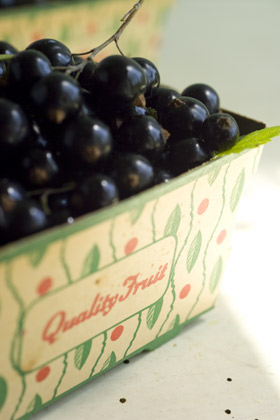
THE ULTIMATE SUMMER HIGH TEA
Wednesday July 09th 2008, 10:08 pm
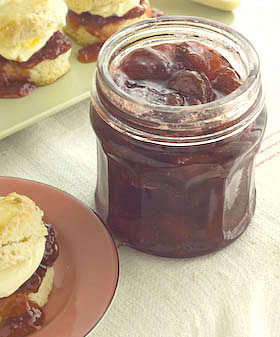
I am currently writing a book on jam making so am busy with a preserving pan. It seems very strange indeed that the end results from combining just two ingredients, fruit and sugar, can vary so much.
A couple of years ago I made some apricot jam and gave a jar to my friend Joy, knowing that she had a particular liking for this preserve and its association, in our minds, with France. She was quite polite but did tell me she had found the jam rather overly sweet. We don’t so often find fresh homegrown apricots on sale in the UK and though I can’t recall the exact details, I had most likely bought imported fruit in the supermarket and was swayed by how nice the amber fruits looked with just a hint of a pink blush that took my thoughts straight to magical times spent in Provence. Back to reality, we all know that out of season imported fruit is usually all blouse and no knickers, rarely matching its promise, and this instance was no exception.
For the book, my criteria required for a recipe to be included is that preserves must capture the real character of the fruit and a sweet nondescript could-be-any-old-fruit taste is certainly not worth the effort involved. As nowadays too much sugar is a bit off putting as well, reducing the sugar content where possible is an added bonus, though the sugar is an essential part of what helps the jam to keep, which means there is a limit to how little you can use. So when I made the best strawberry and vanilla jam I have ever tasted, using locally grown fruit full of the unmistakable flavour of utmost strawberry and which included less sugar than usual, I thought it worth mentioning. As well as that, strawberry jam teams up perfectly with scones and clotted cream for the classic summer treat. What follows is how to make the ultimate scones, jam and cream from scratch for afternoon tea. If you are making this all in one go, you will need to begin two days before as the fruit, vanilla and sugar needs to marinade, or should I say macerate, overnight before you make it into jam and once made it has to be left till cold. The jam has quite a soft set, which again is very lovely and guaranteed to ooze out of the scones.
My Mum always makes scones with dried fruit in them and the habits you grow up with are hard to break away from, but here a plain scone is definitely what is required. Make the scones quite small as well, no bigger than 5cm diameter, just eat twice as many.
Let’s start with the jam…..
FAMOUS FIVE GO MAD FOR MACAROONS
Tuesday April 22nd 2008, 7:05 am
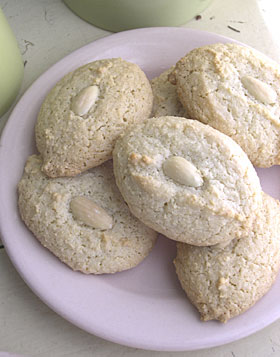
My Mum lives 160 miles away so every morning we speak on the webcam. The other day she was trying to remember someone’s name but, though on the tip of her toungue, the words just couldn’t be found. ‘Oh you know…., Enid Blyton….’ she kept saying, to which I replied, ‘Do you mean Delia Smith?’, and she said ‘yes, that’s who I mean’. This made me laugh out loud, but the more I have thought about it since, the more perfect this juxtaposition becomes.
So in order to find a peg to hang my latest blog post on, here is a recipe for macaroons, which I feel sure would have made fitting fare for The Famous Five (don’t try saying that in a hurry). The ones I’ve made are almond macaroons but they can also be made with coconut or hazelnuts and, I must admit, any variation appeals to me.
Freshly made macaroons are just heavenly and are my new discovery. They are so quick to make, you’ll wonder why you don’t make them on a regular basis. Are they a biscuit, are they a cake? The main thing is not to overcook them. They can bear to be undercooked and squidgy but once high baked they become so hard they hurt your teeth. The first time I made them I lined the baking tray with rice paper because it seemed a nice traditional touch and I just happened to have a packet in the cupboard that had been there for a very long time unopened so it was an oportunity to use it up, but I wont bother in future as that detail has no bearing whatsoever on the finished article.
I’m not sure though that they make a fitting accompaniment to lashings of ginger beer but a cup of tea does the job nicely.
Almond Macaroons – makes 14
150 g ground almonds
200 g caster sugar
3 egg whites
1 level Tbsp plain flour
1 tsp of good quality amond extract
7 blanched almonds, halved
Pre heat the oven to Mk3, 160C, 325F.
Mix the almonds and sugar then stir in the egg whites, followed by the flour and extract. Place dessert spoonfuls, spaced apart on a baking tray. Push a halved almond on the top of each macaroon and bake for 20 – 25 minutes till just starting to appear golden. Keep you eye on them, you don’t want them to be overcooked. Leave to cool on a wire rack. They firm up as they cool.
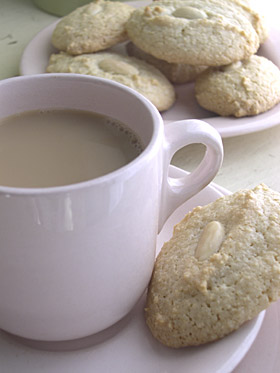
EVERYONE NEEDS A FRIAND
Thursday April 17th 2008, 10:02 am
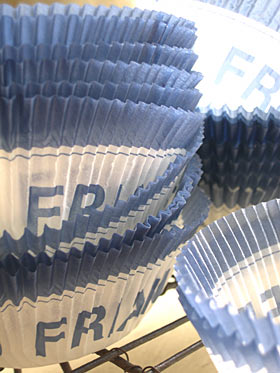
I first came across friands when travelling in Australia and New Zealand. These little cakes seemed as common as muffins over there, served in coffee shops everywhere I went, and yet I had never heard of them before. Presuming them to be of French origin I thought I’d look them up when I got home, expecting to find them referred to in Elizabeth David or some such. After extensive research and unable to find any mention of them anywhere, I had to surmise that they are in fact an Australasian invention with a French sounding name.
They are similar to a little French cake called a financier, made with ground nuts as the main ingredient and very little flour. This of course results in a lovely moist cake. They are easy to make, thrown together with the butter melted not creamed (what can be easier than that?) and the mixture is barely combined. The nuts and egg whites make them slightly superior to a muffin ( whilst a muffin looks up to a friand but down to a fairy cake – the fairy cake says ‘I know my place’), but the extent of their variations with different nuts and added fruits means they are just as versatile. A perfect cafe cake or a special little treat to serve up when a friend calls round for tea.
They have become a bit of an obsession of mine and I have collected lots of recipes. Having said that they are a cinch to make, I am in fact starting with a recipe that calls for a fair bit of extra messing about, which isn’t usually what is required but it seems like a good opportunity to use up some more rhubarb.
For these rhubarb friands the fruit is added to each one in the form of an frozen cube made of rhubarb puree. Subsequently you have to think ahead, making and freezing the cubes beforehand. When the cake mixture is spooned into the tins a cube of puree is popped into the centre of each one prior to baking. It is an interesting idea as it keeps the filling together in the middle of the cake. Freezing fruit puree like this is a good way of preserving fruits when there is a plentiful supply for use later out of season. If you think this is just too much faffing about, you could try putting a teaspoonful of rhubarb compote in the middle of each one and hope it doesn’t ooze out all over the place.
Here is the recipe.
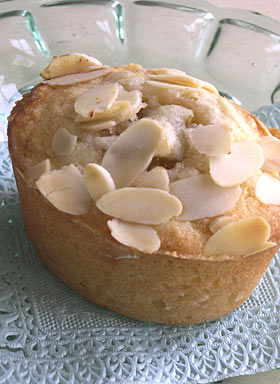
LET’S GET READY TO JUMBLE
Friday March 14th 2008, 6:30 pm
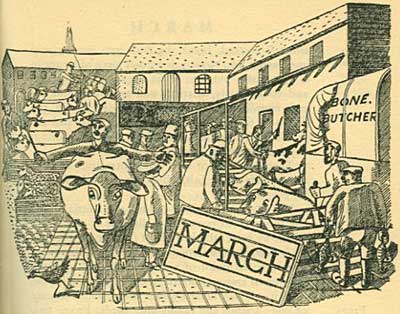
I went up north for a few days last week and made sure to visit the car boot sale in Preston whilst I was there. It is the best sort of car boot, in so far as there is always so much total rubbish on sale that it fills you with optimism that a bargain is just waiting to be found in one of the grubby house clearance boxes.
I only bought 3 old cookery books but felt that my rummaging time was time well spent. One of the books, Good Food by Ambrose Heath, is an absolute corker. Unfortunately, it long ago lost its dust jacket (which I would love to see) and from the outside it seems quite uninspiring, battered linen, aged and discoloured beige, but inside is such a treat. It is often said that nothing is new and this book clearly proves the point. It is set out month by month with recipes using seasonal produce and rather than the recipes being laid out in the usual manner it has running text with the recipe headings written in the margins. A bit like Nigella Lawson’s How To Eat. I bet you anything that in the editorial meeting when they came up with the format for Nigella’s book they thought they were being groundbreaking. In fact they were pipped to the post by 70 years, Good Food was published in 1932.
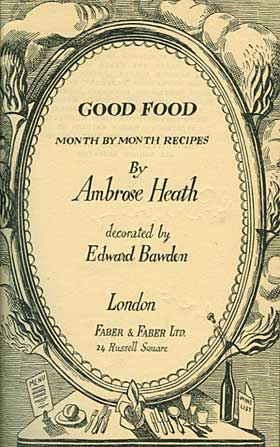
To make the book even more fabulous it is illustrated by Edward Bawden, with an image to represent each month as well as some smaller incidental images of cooking implements and produce. If only it still had its dust jacket, I imagine that would be really special. Of course now I am on Ambrose Heath alert and am looking out for more of his books. Apparently he was a very prolific cookery writer (1891-1969) and wrote around 100 books on just about every food subject and ingredient under the sun. I would particularly like to see ‘Open Sesame – The Way of a Cook With a Can’ published in 1939 (sorry Delia, he beat you too it).
Anyway, keen to try out some of his recipes I spotted one for Orange Jumbles, which are a flat sprawling biscuit made with flaked almonds and orange rind and juice. I am getting ahead of myself here as they are in the April chapter but as we can usually find oranges of some kind all-year-round and recipes with funny names are always a good thing then why not?. I decided to experiment and have had to make them a few times to get the recipe right – hard work but somebody had to do it. I have substituted some of my Seville marmalade as an ingredient, missed out cochineal, who on earth uses that these days, and they seem to have worked out pretty well. Ambrose didn’t seem to believe in molly-coddling his readers and the recipes are suitably vague on technique.
Of the Orange Jumbles he writes, ‘To say that they are indescribably charming really describes them’. If I wasn’t so busy eating my way through a plate of jumbles I’d say ‘I couldn’t agree more’.
Here’s my recipe for Marmalade Jumbles.
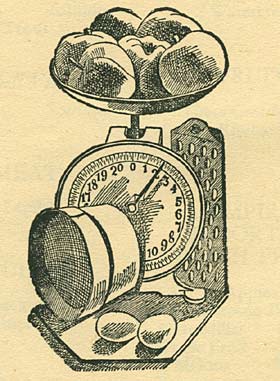
HELLO GRANOLA WORLD
Monday February 25th 2008, 10:19 am
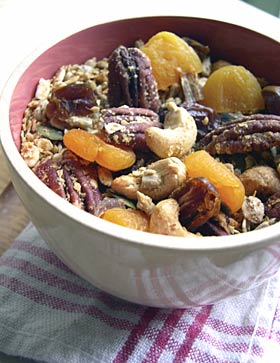
What did we ever do before the world wide web? I was curious to find out whether granola is a trade name or not and a quick Google search instantly told me it once was, still is in Australia but no longer is everywhere else. Wikipedia has come in for a lot of stick in the press recently for being unreliable as it is public participation that keeps the information it contains updated and accurate. That means you and me could make up any old tosh and contribute to an encyclopedia of pure bunkem, if we so wish.
According to Wiki-P, “Granola” is used as a slang term (metonym) describing a person who is hippie-like, a modern bohemian, environmentalist, or leftist in outlook. I have never heard anyone referred to as a ‘Granola’, though as insults go it could be worse. In fact I have decided to become a Granola.
I can’t believe that I’ve never made granola before, an oat-based whole-foodie concoction that contains seeds, nuts and grains and is slightly sweetened with honey, maple or sugar syrup. The combination of ingredients can be just about any mix you like and baking in the oven toasts it all nicely and heightens the flavours.
I am never sure whether it is good to make things that you can’t stop eating or better to not make them at all and for me granola falls into this category. The real jewels in the mix, the whole cashews, chopped apricots and toasted pecans sit on the top shouting ‘eat me’ and I duly oblige everytime I walk through the kitchen. Paul McKenna promotes a strange tapping technique to overcome cravings so I am often to be found in the kitchen staring at the jar of granola whilst tapping my head in the McKenna-style.
Granola is fabulous served with natural yoghurt for breakfast and full of good things to help keep you going all day. For a rather more special dessert, mix mascarpone with plain yoghurt, maple syrup and a spash of good vanilla extract and add the granola to that. Serve in precious little ramekins to make it seem even more special. Here is a recipe to get you started but really, this is a freeform thing, so go with the flow and improvise.




